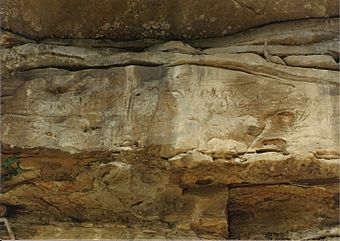Red Bird River Petroglyphs facts for kids
|
Red Bird River Petroglyphs (15CY51)
|
|
|
Formerly listed on the U.S. National Register of Historic Places
|
|

Red Bird River Petroglyphs, in situ overlooking Red Bird River, circa 1988
|
|
| Lua error in Module:Location_map at line 420: attempt to index field 'wikibase' (a nil value). | |
| Nearest city | Eriline, Kentucky |
|---|---|
| Area | less than one acre |
| MPS | Prehistoric Rock Art Sites in Kentucky MPS |
| NRHP reference No. | 89001182 |
Quick facts for kids Significant dates |
|
| Added to NRHP | September 8, 1989 |
| Removed from NRHP | December 4, 2003 |
The Red Bird River Petroglyphs are ancient carvings made on a large stone. These special markings are found in Clay County, Kentucky. A petroglyph is a picture or symbol carved into rock by people long ago.
This important stone was once located next to the Red Bird River. But in 1994, it fell onto a road. To protect it, the stone was moved to a park in Manchester, where you can see it today.
Contents
What Are the Red Bird Petroglyphs?
The Red Bird River Petroglyphs are unique carvings. They are different from other rock art found in Kentucky. The carved surface of the stone is about 1.6 meters (5.5 feet) tall and 6 meters (20 feet) long.
These carvings were originally much closer to the ground. Over time, road construction caused the ground level to change. This left the stone about 16 feet above the road.
Where Can You See Them Now?
On December 7, 1994, the huge 50-ton stone fell from a cliff. It landed on Kentucky Route 66. Just two days later, on December 9, 1994, the stone was moved.
Today, the Red Bird Petroglyphs are safe in Rawlings/Stinson Park in Manchester. They are protected by a roof and a fence. The original site was listed on the National Register of Historic Places in 1989. However, it was removed from the list in 2003 after the stone was moved.
Who Made These Carvings?
A state historical marker near the river says that the carvings were made by a Cherokee leader. His name was Chief Red Bird. The river itself is named after him.
Dr. Kenneth Tankersley, a researcher from the University of Cincinnati, has studied these carvings. He believes Chief Red Bird, whose Cherokee name was Dotsuwa (meaning "Cardinal"), spent a lot of time hunting and trapping in this area.
Chief Red Bird and his friend Will Emory were Cherokee. They lost their lives in a conflict over furs with two men near the Red Bird River Petroglyphs. This happened around 1796 or 1797. It is thought they were buried on the opposite side of the river. Many of Red Bird's family members still visit these important sites today.
What Do the Carvings Mean?
According to Dr. Tankersley, the carvings tell a story. The left part of the Red Bird River Petroglyphs shows symbols for the Deer and Bear clans of the Cherokee people.
The middle part of the stone has symbols for the Chickamauga people. These carvings might tell the story of where they came from. There are also symbols for the Bird and Bear clans. Many people believe these petroglyphs have always been connected to Chief Red Bird.
Other Ancient Writings?
A sign next to the stone in Manchester mentions something very interesting. It says that the stone has carvings from at least eight different ancient alphabets. These alphabets were no longer used by the time Christopher Columbus arrived in the Americas in 1492.
Some of the alphabets mentioned include early Greek and Hebrew. There are also Old Libyan, Old Arabic, and Iberian-Punic writings. The Iberian-Punic carvings might be from as far back as 900 BC. Other ancient scripts like Ogam, Germanic runes, and Tiffinag-Numidian are also said to be on the stone.


